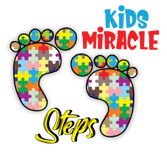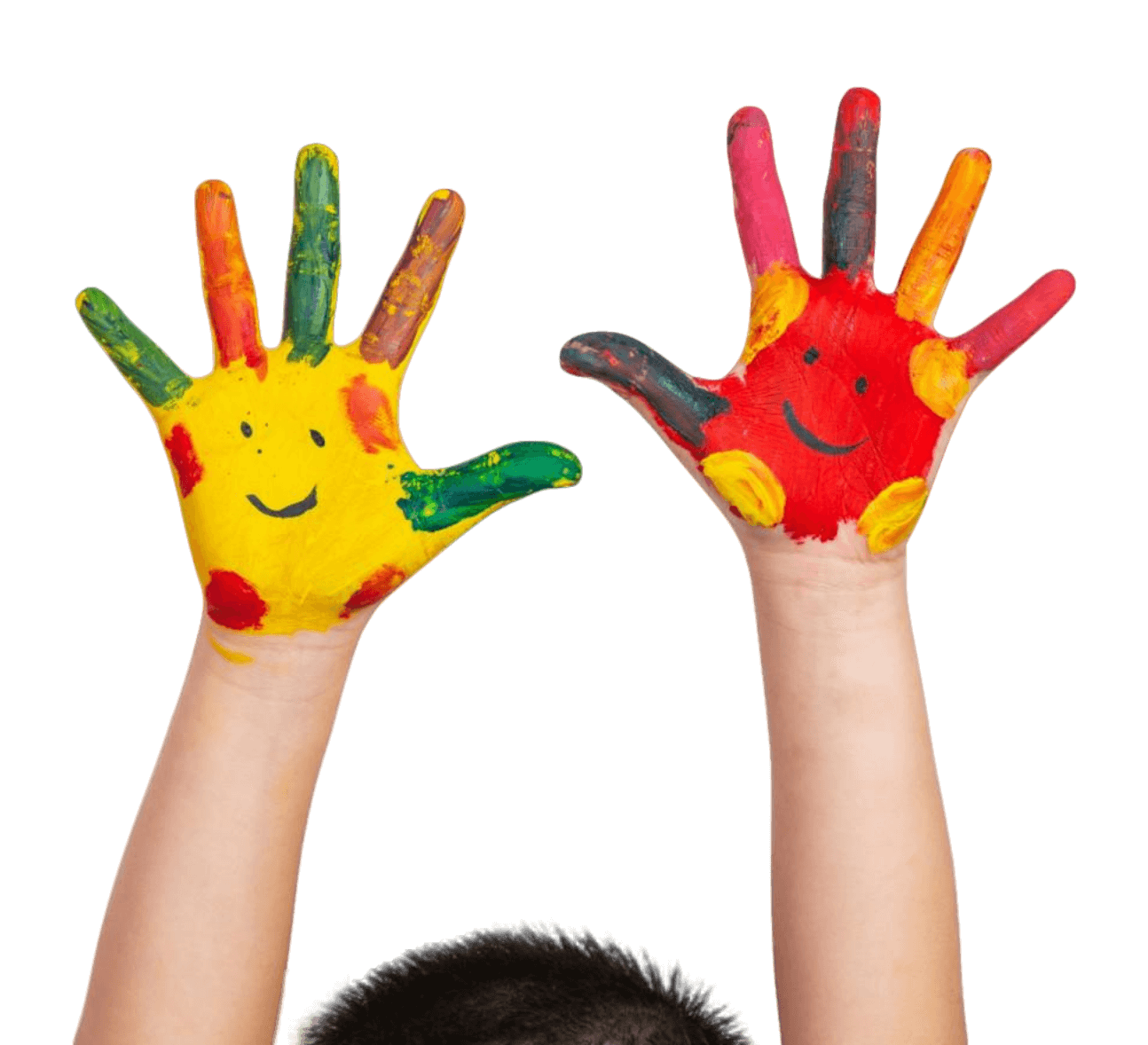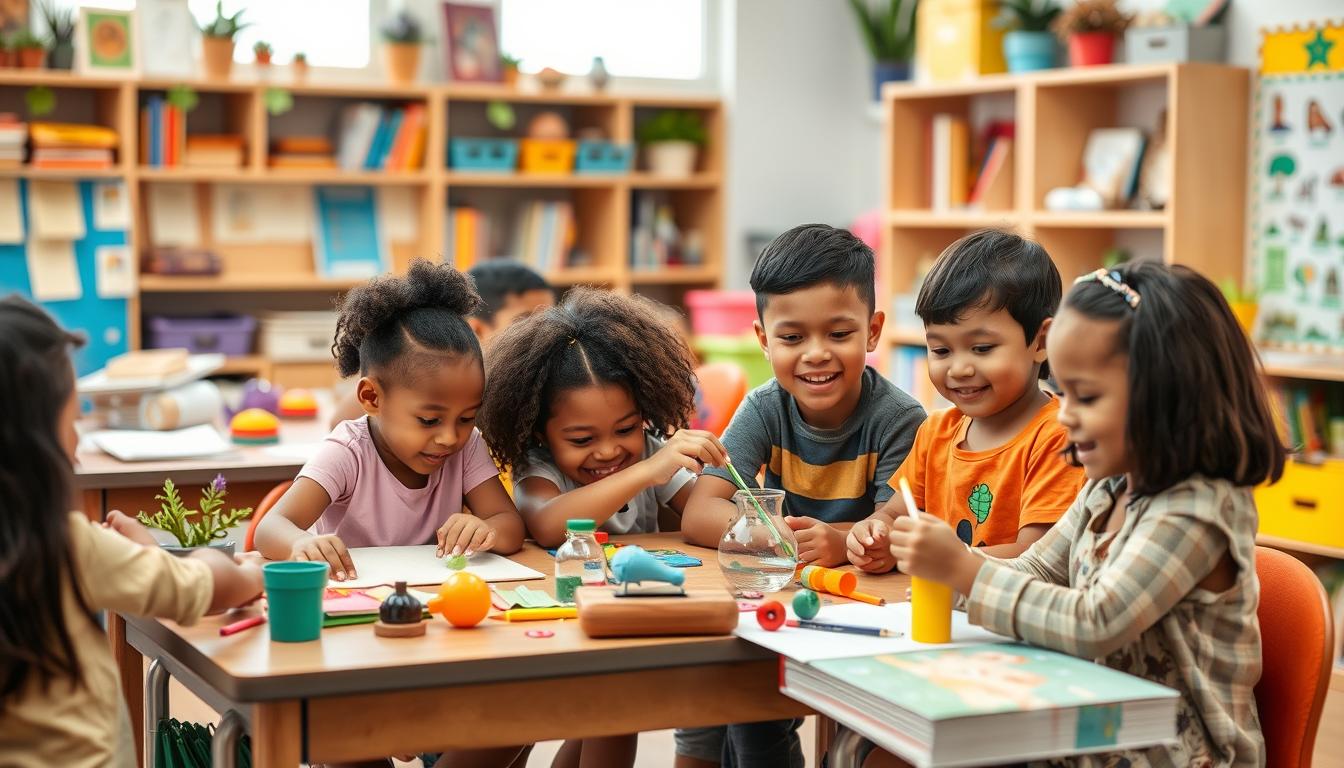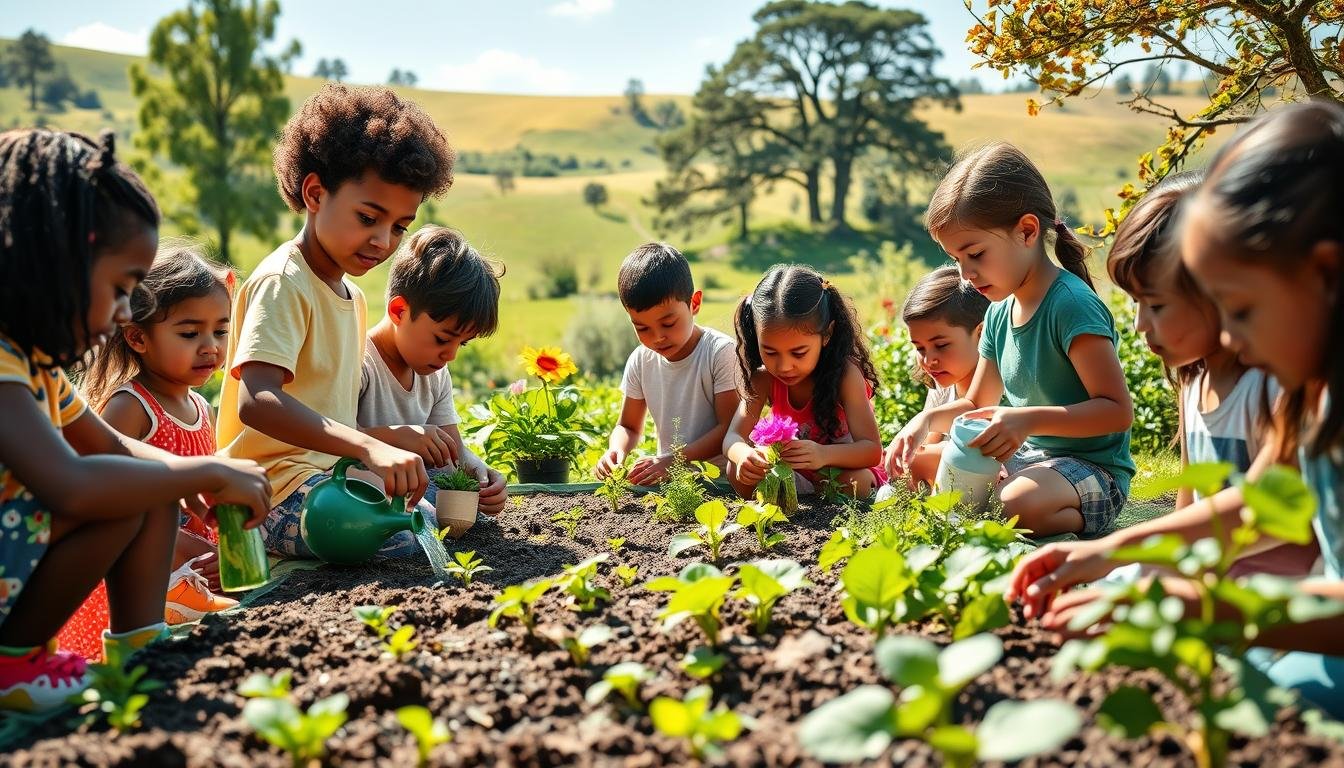As parents, we love it when our kids discover something new. Their eyes light up with understanding. But do we really teach them to love learning or just memorize things? This is a crucial question for raising curious and motivated kids. It’s about making learning joyful and meaningful.
Think back to your school days. How often did you just memorize stuff without understanding it? This approach made learning feel like a chore, not an adventure. Today, 80% of students tie their self-worth to grades, a University of Michigan study found. This shows how important it is to change how we teach.
Imagine learning as an exciting journey, not a race. We should teach kids in ways that make learning fun and engaging. Kathy Seal, coauthor of Motivated Minds: Raising Children to Love Learning, says kids who love learning do better in school and life. By focusing on joy in learning, we can help our kids love education. So, we should create learning environments that are fun and active. This way, our kids can truly love learning.
Understanding the Difference Between Learning and Memorizing
Learning and memorizing are two different things in education. Learning is about understanding and applying what you know. Memorizing is just about remembering information for a short time. Many high school graduates remember the slope-intercept formula, y=mx+b. But, not many know how to use it in real life. This shows the difference between knowing something and really understanding it.
Memorizing can help you get good grades, even if you don’t fully understand the material. But, understanding is better because it lets you use what you know in different ways. Teachers say it’s important to memorize key ideas in subjects like Energy and Thermodynamics.
While memorizing can be helpful, it’s not as good as learning. For example, students might just remember historical facts instead of really understanding them. But, when you practice recalling information, you learn it better and can use it in different ways.
The table below shows how memorizing and learning are different:
| Aspect | Memorizing | Learning |
|---|---|---|
| Duration | Short-term retention | Long-term understanding |
| Application | Limited to recalling information | Ability to apply knowledge in various contexts |
| Depth | Surface-level knowledge | Deeper understanding and connection-making |
| Flexibility | Rigid recall without adaptation | Adaptive and flexible application |
While memorizing is useful, the main goal of education is deeper learning. This way, students develop a strong understanding and can apply what they know in many situations. This approach helps students become adaptable and proficient, ready to succeed in different learning environments.
The Role of Phonics vs Whole Language in Learning
The debate between phonics and the whole language approach in reading education is big. Phonics has been around since the 1600s, linking sounds and letters. The whole language method, starting in the 1980s, focuses on reading whole texts to learn naturally. This topic has sparked a lot of discussion among teachers, with many studies backing their views.
A study in Scotland showed that students learning only phonics read slower and understand less than those with a mix of methods. Both phonics and whole language have their good points. But, using both together, called balanced literacy, works best for different learning styles.
The National Reading Panel says there are five key areas for reading skills: phonemic awareness, phonics, fluency, vocabulary, and comprehension. This shows that just phonics or whole language isn’t enough. Mixing both methods gives kids a strong reading foundation.
Students learning only phonics struggle with new words by age 11. University students taught only phonics also fall behind in fluency and comprehension. But, kids learning both phonics and whole language do better as they get older. This shows the need for different reading methods.
Teachers say teaching phonics early, in preschool or kindergarten, works best. But, adding whole language helps with writing, vocabulary, and spelling. This mix is key for students’ success.
| Aspect | Phonics | Whole Language Approach |
|---|---|---|
| Effectiveness | More effective when systematic and early | Strengthens writing, vocabulary, and spelling |
| History | Used since the 1600s | Developed around 1980 |
| Focus | Sound-letter correlation | Exposure to complete texts |
| Learning Outcomes | Effective for early reading | Enhances comprehensive literacy skills |
| Suited for | Systematic instruction, beneficial for dyslexic students | Rich literacy environments, overall literacy development |
Choosing between phonics and whole language is not a simple decision. A balanced literacy approach that combines both is best. It meets the varied needs of children, offering a supportive and effective path to reading.
Evaluating Your Child’s Learning Style
Every child learns in their own special way. They can be visual, auditory, or kinesthetic learners. Knowing your child’s learning style helps teachers and parents teach better. This leads to better learning results.
Visual learners love pictures and charts. They understand better when they see things. Auditory learners do well with hearing and talking. They like to discuss and debate. Kinesthetic learners need to move and touch things to learn. Teaching to a child’s learning style helps them learn more. This makes learning more fun and personal for everyone.
Here are some benefits of matching your child’s homeschool to their learning style:
- They learn better and remember more.
- They become more independent and confident.
- They do better on tests and manage their time well.
- They think more critically and move to higher thinking levels.
- They focus better, making learning more exciting.
Parents can find out their child’s learning style in many ways. They can search online, read reviews, ask homeschooling groups. Knowing this helps make education more personal and effective for your child.
| Learning Style | Characteristics | Effective Techniques |
|---|---|---|
| Visual/Spatial | Prefers images, diagrams, and spatial understanding | Use graphics, charts, and visual organizers |
| Auditory/Aural | Retains information through listening and speaking | Engage in debates, discussions, and verbal repetition |
| Physical/Kinesthetic | Learns best through movement and hands-on activities | Incorporate hands-on tasks and frequent breaks |
By figuring out your child’s learning style, you can make learning better. This way, they will love learning instead of just memorizing.
Techniques for Teaching Critical Thinking
Teaching your child to think critically is key. It helps them analyze information, consider different views, and make smart choices. Conscious parenting means teaching kids to think for themselves. This takes effort, intention, and flexibility from parents. Let’s look at some ways to boost critical thinking skills.
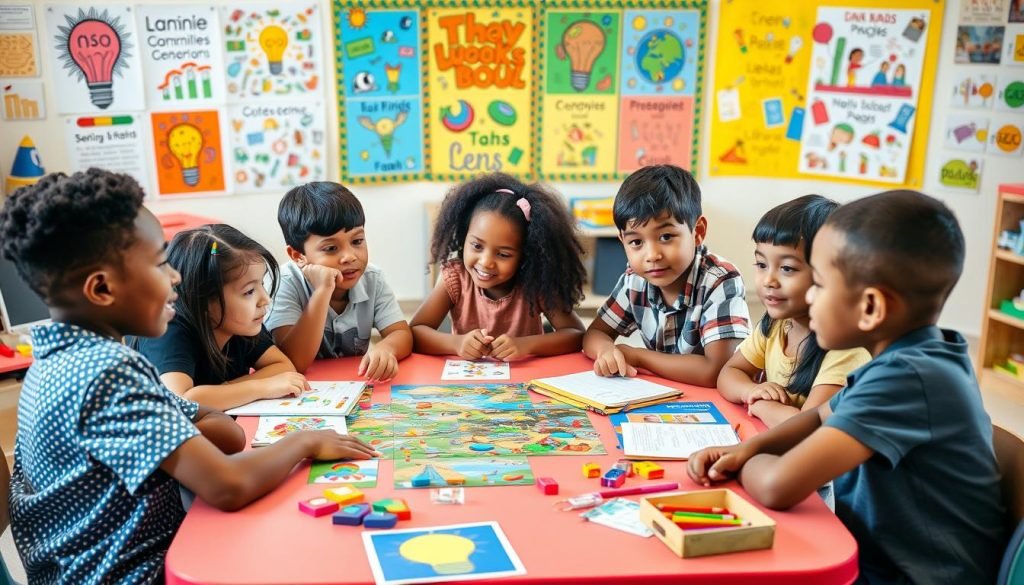
It’s vital to teach problem-solving skills. Creative teaching methods are more effective than just memorizing facts. For example, using open-ended questions helps kids think deeply about their answers.
- Ask “What do you think?” questions to promote independent analysis.
- Encourage hypothesizing during play to stimulate curiosity and imaginative thinking.
Role-playing is another great way to teach critical thinking. It lets kids think from different perspectives and make choices. This helps them understand complex issues better. Problem-solving exercises are also effective. Giving kids puzzles or challenges helps improve their analytical skills. As they tackle more complex problems, they build confidence and resilience.
| Technique | Benefit |
|---|---|
| Open-ended Questions | Stimulates deep thinking and independent analysis |
| Role-playing Scenarios | Encourages perspective-taking and decision-making |
| Problem-solving Exercises | Enhances analytical skills and resilience |
Encourage your child to ask questions. Questioning the world and even your parenting helps their critical thinking. It leads to meaningful conversations and a supportive environment. Showing critical thinking yourself is also important. As a parent or teacher, sharing your thought process teaches kids the value of reasoning. This helps them learn to examine issues critically and make informed decisions.
Using creative teaching methods, like play, is beneficial. Play helps kids reflect and solve problems in a fun way. It’s a great way to develop critical thinking skills. Teaching critical thinking is a journey that changes lives. By using these techniques, parents and educators can create an environment that encourages critical thinking and a love for learning.
Effects of Memorization on Gifted Children
Gifted children often show amazing skills and interests early on. For example, Level One gifted kids are interested in many topics by age two. They also excel in language by age three. But, rote learning, where students memorize information through repetition, can block their natural curiosity and love for learning. Too much focus on memorization makes learning dull for gifted kids. They love solving problems and exploring new ideas. So, repetitive tasks can make them lose interest and slow down their growth.
It’s key to use different teaching methods to keep gifted kids engaged. Unlike old ways of learning, new methods can match their unique skills. This way, they can grow intellectually and stay excited about learning. Standard tests and talent searches often miss many gifted kids, especially those from tough backgrounds. About 60% of gifted kids are overlooked by teachers because of biases. By understanding the harm of rote learning and meeting each child’s needs, we can help them succeed.
The Importance of Engaging and Meaningful Content
Creating engaging educational content is key to making learning fun for kids. Studies show that when kids pick their own topics, they learn better and stay interested. By linking subjects to real life and encouraging hands-on activities, we meet their interests and help them understand better.
Hands-on learning is a powerful way to make learning meaningful. Activities that use sight, sound, and touch help all kids learn. For example, science experiments, art, and music make complex ideas easy to grasp. Challenges help kids grow and learn. When we teach them to see challenges as learning chances, they become more resilient and persistent. Research from Stanford shows that focusing on effort, not just talent, leads to better learning.
The National Association for the Education of Young Children (NAEYC) supports playful learning. It makes learning fun and interactive, boosting vocabulary and spatial skills. This approach fits well with learning goals and helps kids grow in a natural way.
Changes in education, like the No Child Left Behind Act, have led to more structured learning. But recent studies show that playful learning is better for kids. It makes learning fun and helps kids understand and enjoy their education more. Creating content that truly connects with kids is at the heart of our mission. We aim to create a positive and supportive learning space for every child.
Strategies for Teaching Your Child to Love Learning
Teaching kids to love learning is more than just schoolwork. It’s about creating a place where they can explore and be creative. Letting them choose what they want to learn makes them more excited about it. Studies show this method really works.
Using hands-on learning is key. Kids who get to do things with their hands learn better and have more fun. Things like crafts and science experiments make learning real. Play and discovery are also important. Fun activities like songs and games make learning fun. It’s also good to know how each child learns best, like through seeing, hearing, or doing.
Showing your own love for learning is powerful. Your excitement can make your kids excited too. Talking with them instead of just telling them things helps them think and learn more. It’s also important to support and encourage your child without pushing too hard. Praising their effort and curiosity helps them love learning. Plus, doing speech therapy at home can help them feel more confident and ready to learn.
- Letting kids choose what they want to learn.
- Doing hands-on activities.
- Using play and discovery in learning.
- Knowing and using each child’s learning style.
- Having open discussions instead of lectures.
- Supporting and encouraging without too much pressure.
By using these strategies, we help our kids become lifelong learners. Making learning fun and meaningful helps them find their passions and do well in school and life.
Conclusion
Fostering educational success means knowing the difference between real learning and just memorizing. Children do best when they think for themselves, connect with what they learn, and love to learn. Using phonics or whole language, figuring out how kids learn best, and making learning fun can really help.
Studies back up these ideas. They show that how classrooms are set up matters for learning, friends can help with language, and math and problem-solving skills are key. Parents’ beliefs and backgrounds also shape their kids’ learning environment, showing how important it is for home and school to work together.
If you want more help and resources, Kids Miracle Steps has great services. They help kids, especially those with special needs, do well in school. By using the tips we’ve talked about and getting more help, we can make sure our kids are ready for school and love to learn.
